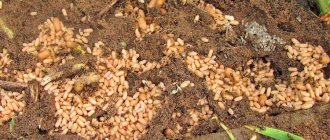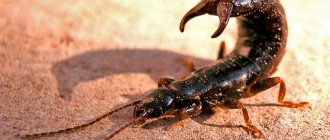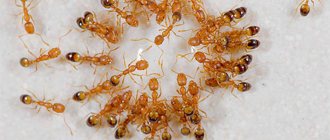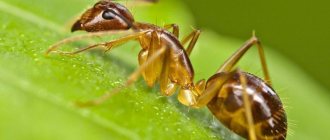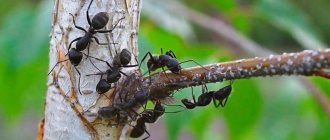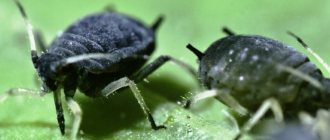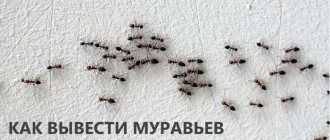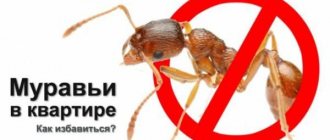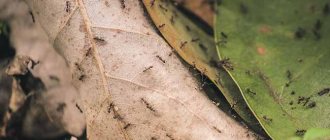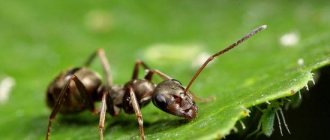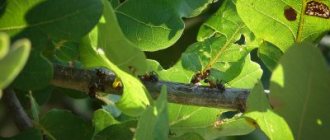A colony of ants in a garden bed is a dubious joy for a gardener, and the appearance of such newcomers in a greenhouse is a double disappointment. After all, in a place where the most comfortable conditions have been created that protect plants from the vagaries of weather and diseases, the last thing I would like to see is “neighbors” causing damage to the harvest. We tell you what folk methods will help drive ants out of the greenhouse.
Repelling ants with herbs
Ants are considered susceptible to the strong odors that some plants emit. This property is used to drive insects out of the greenhouse. Suitable for “aroma fighting”:
- mint;
- sagebrush;
- carnation;
- garlic;
- mustard.
Herbs are laid out between greenhouse plants. Ants especially do not like the smell of garlic. It is recommended to grind it, add it to sawdust and sprinkle the mixture near the entrance to the anthill. An infusion made from a head of garlic and a bucket of water is more effective. After keeping the mixture for a day, it is watered where insects are active.
The disadvantage of this method is that the ants will simply change their location, but after a while they can return again.
What effect do ants have on plants?
Ants are important to nature and provide the following benefits:
- Destroy pests and their larvae, in particular spider mites;
- They loosen the soil, so that more oxygen begins to flow to the roots of plants;
- The waste from their vital activity is fertilizer for plants;
However, the harm from their presence overshadows all the benefits, since they:
- They destroy plant seeds, which is why seedlings do not germinate;
- They feed on sprouts;
- Aphids are bred on cultivated plants;
- They interfere with cultivating the beds and destroying weeds.
Thus, ants do more harm than good. Therefore, when they appear, it is necessary to take immediate action; if the anthill grows, it will be even more difficult to get rid of them.
Using boric acid to fight ants
Experienced gardeners call boric acid one of the best alternative means for fighting ants. The drug acts as a high-quality insecticide, but does not harm plants and does not accumulate in fruits.
To prepare the bait you will need:
- 10 g boric acid;
- 2 tsp. honey;
- glass of water.
Heat the water until it is slightly above room temperature. Dissolve boric acid and natural honey in it. We pour the resulting mixture into nylon lids and place the bait next to the anthill and on active trails.
Destruction of the uterus
It often happens that after a serious chemical treatment is completed, insects disappear for a certain period of time and then appear again. Pesticides kill only adult individuals, while the queen continues to actively reproduce.
The queen lives in the depths of the galleries and is extremely difficult to find. Therefore, experts have come up with the most effective way: you need to make sure that the poison gets to the female from the ants. When it is destroyed, the nest will also spread.
To destroy pests in a greenhouse, you need to get rid of the main root of the problem - their uterus. For these purposes, you will need to dig up the soil, as well as carefully examine it, trying to find the largest ant that lays eggs.
Wait for her to appear
Regular loosening of the soil near plants also helps reduce the number of pests, or forces them to change their habitat. This is due to the fact that the nests and passages that are used for movement are constantly being destroyed. When, during loosening, it was possible to find and get rid of the queen, the anthill ceases to exist.
Preparation of a weak poison
When the poison left by insects acts very quickly, they do not have time to convey it to the female. And if the effect is insignificant, slow, over time the queen will be killed.
To prepare a weak bait, an ordinary sweet solution of boric acid is made, in which cotton wool should be soaked and thrown inside the jar. The trap is covered in such a way that insects can get inside. They bite off pieces of cotton wool and bring it to the female. After 15 days, you need to update the contents, reducing the concentration of the solution over time. After 6 weeks, the colony will be completely destroyed.
In addition, you can mix honey and dry boric acid in a ratio of 2 to 1, add 2 drops. water and stir, making the mixture quite thick. Such bait is placed on ant paths. After this, you need to wait for it to be delivered to the female. If the acid penetrates inside the ant, it will initially begin to itch and then be destroyed.
Using semolina to fight ants
A folk method based on the characteristics of the digestive system of ants. The absorbed cereal is not digested, but swells, which leads to the death of the insect. The advantage is that the ants can also serve semolina to their queen as food. If this happens, you will defeat the entire family.
To make semolina more attractive to insects, it is recommended to mix it with powdered sugar. The resulting mixture is scattered along the paths, paying special attention to the entrances to the anthill.
Chemicals
A huge number of different pesticides are sold that do an excellent job of killing ants: long-acting gels, powders, and crayons are common. Keep in mind that they are recommended to be used when it is not possible to get rid of insects using folk remedies that are safer for plants . To properly deal with ants, familiarize yourself with the distinctive features of toxic compounds:
| Drug name | Active ingredient | Operating principle | Characteristics of the drug | Application | Price |
| "Thunder-2" (10 g) | Diazinon. | Destroys ant colonies. Adults eat the product, feed it to the larvae, poison the body: insects experience convulsions, paralysis, and suffocation. | It has a pleasant aroma for ants. Effectively fights soil flies, fungus gnats, and ants. Used in garden plots, greenhouses, apartments. | The top layer of the anthill (2-3 cm) is removed, the poison is poured out (if the nest is large, use 2 packages), a layer of earth is poured in, and a sheet of plywood is placed. | 11 rub. |
| "Muracid" (10 ml) | Diazinon. | Contact intestinal poison. Adults and larvae die after a day: spasmodic pain and paralysis occur. | Safe for people, animals, plants. The effect of the poison lasts 2-3 months, so it can be used 1-2 times per season. | 1 ampoule of 5 ml is mixed with 10 liters of water. The solution is used to treat areas where pests accumulate. | 51 rub. |
| "Aardeater" (1 ml) | Diazinon. | Noticeable effect after 3 days. Contact-intestinal effect: causes paralysis, leads to rapid death. | Release form: ampoules. Effectively fights against different types of insects: mole cricket, wireworm, weevil, fruit moth, cabbage fly, ants. | For processing 5 sq. m use a solution of 1 ml of the drug, 10 liters of water. Carry out the procedure in the morning or evening: remove the top layer of the nest, pour in the solution. | 16 rub. |
| "Ant" (10 g) | Diazinon. | Poisons the uterus. | Granular powder. Suitable for garden plots and residential premises. Protects vegetable and flower crops, fruit trees, berry bushes, lawn grass. | Buried inside the nest to a depth of 2-3 cm. Consumption rate: 30 g per 10 square meters. m. | 14 rub. |
| "Delicia" (500 g) | Chlorpyrifos. | Rapid poisoning of adults and larvae. | Universal granular powder. Helps fight ants, lice, crickets, larvae, ticks, cockroaches, fleas. | Nests are falling down. | 665 rub. |
| "Raid" (300 ml) | Butane, propane, isobutylene, solvents, fragrance. | Remains active for 2-4 weeks. Nerve-paralytic effect: the poison enters the body, penetrates the cover, and destroys the pest. | The aerosol helps fight ants, bedbugs, fleas, cockroaches, moths, mosquitoes, flies, mosquitoes, and skin beetles. Safe for people. It has a pleasant lavender scent. | Shake the container well before use. The product is sprayed inside the greenhouse, where there are pests, from a distance of 20-30 cm, for about 2 seconds: droplets should not be allowed to form on surfaces. | 294 rub. |
| "Karbofos" (30 g) | Malathion. | It is an enteric contact agent: if it comes into contact with or inside an insect, it has a detrimental effect. | It has an unpleasant odor that helps fight pests, which quickly disappears. Can be used in garden plots to kill bedbugs, red and black ants, mites, aphids, moths, moths, mosquitoes, lice, and bees. | Can be used up to 2 times per summer. Take 10 liters of water and add 60 g of dry powder. Solution consumption: 1-2 l per 10 sq. m. | 30 RUR |
Using wood ash to fight ants
Most often, gardeners use wood ash for fertilizing, but it is also an effective means for eradicating pests. To drive away ants with its help, the combustion product directly with smoldering coals must be poured onto an open anthill. After a couple of weeks, the procedure is repeated.
Where did they even come from?
If ants appeared in a greenhouse, there could be three reasons: The insects went their own way and turned into the greenhouse to investigate. The important thing here is to simply kick them out in time. A new nest has appeared on your site, and pests go to the greenhouse to grow aphids there - it’s more convenient.
Just get rid of the aphids and scatter the cut garlic cloves over the beds. The nest appeared right inside the greenhouse, by digging from outside. It’s not so easy to find - you won’t see any anthill, it’s just a small hole, under which, however, a whole kingdom is already being built. Search and destroy.
First of all, figure out what kind of enemy wandered into your greenhouse. Thus, in Russia the following types of ants are most often found: Black garden ants. Red forest ones. Brown meadows. If your site is located near a forest, expect red insects to visit you, but they usually avoid the greenhouse.
But closed, warm soil is more attractive to black garden ants, which brazenly build their nests right in the beds. And with our multiple passages underground, we disrupt the root system of everything that grows in the greenhouse, which is why we may not get a harvest.
At the same time, black ants feed on plant seeds and seedlings. But if you meet one of these comrades, proceed very carefully:
Making traps for ants
You can reduce the number of ants in a greenhouse using simple traps. Glass jars with leftover jam are suitable for such purposes. The sweetness will attract insects, but they will not be able to get out. Brewer's yeast mixed with honey can also be used as bait. Place a couple of spoons of the mixture at the bottom of the jar, then place the vessels along the ant path.
Since only working insects suffer from this method, over time the queen will restore the population. But traps will help buy time until more radical methods take effect.
Mechanical methods of influence
Remember that pests produce acid, which greatly increases the acidity of the soil, as a result of which the soil has to be limed. Ants are carriers of weed seeds, which quickly germinate and choke out garden crops. Insects feed on young shoots and juicy fruits, which is why plants slow down, get sick, and die . The following methods will help protect the crop:
- Regular loosening of the soil - this method creates an unfavorable environment for ants to settle and reproduce; they quickly leave the home. You have to loosen the soil several times during the summer. If you do not follow the procedure, then soon new ant colonies will be found in the greenhouse.
- Destruction of anthills - the “dwelling” is filled with boiling water or kerosene, the nest is destroyed, and if necessary, the manipulations are repeated. The method is effective, but does not protect against the proliferation of insects near the treated area.
- Opening a greenhouse in the autumn-winter period to freeze the top layer of soil is one of the most effective ways to prevent the subsequent establishment of pests: after harvesting, dig up the bed, open a greenhouse to freeze the top layer of soil where the eggs are stored.
- Covering the anthill - use material that does not allow sunlight to pass through. When the heat stops flowing, the individuals will leave their shelter. Please note that you will have to wait about 3 days for a positive result. The method is very effective, it helps not to destroy, but simply to drive away the colony. If you find a new home, repeat these steps.
- Digging a trench around the greenhouse - due to such a barrier, it is possible to protect the greenhouse from attack by pests. A trench is dug, after which the depression is covered with cellophane (fix it with stones) and filled with water.
What to do
There are many methods that can help if there are ants in the greenhouse. The effectiveness of these methods varies, but from them each gardener will be able to choose the most suitable one for his garden.
All these methods can be divided into a number of groups:
- Physical.
- Chemical.
- Combined.
- Industrial pesticides.
Let's take a closer look at each of these methods.
Physical
First of all, you need to find places that ant families have chosen for themselves. These insects love to settle under old boards, sheets of slate or roofing felt lying on the ground, as well as in the wooden structures of greenhouses and greenhouses themselves, especially if the wood is rotten.
Thus, if you remove wood from greenhouses, thereby depriving insects of comfortable living conditions, you can reduce their colony.
Before you start planting, you can spill the entire soil with an aqueous solution of soda and linseed oil (5 g of soda and 30 g of linseed oil per 1 liter of water), which will force the ants to leave the greenhouse.
If you are willing to spend the time and effort to excavate in your own greenhouse, you can dig up the ants' nest and find the queen. By destroying it, you will destroy the entire settlement.
Deep digging of the soil in the greenhouse in the fall and spring, as well as frequent loosening of the soil in the summer months and regular sprinkling of discovered anthills and tunnels with ash, baking soda or quicklime will lead to the colony leaving the territory.

